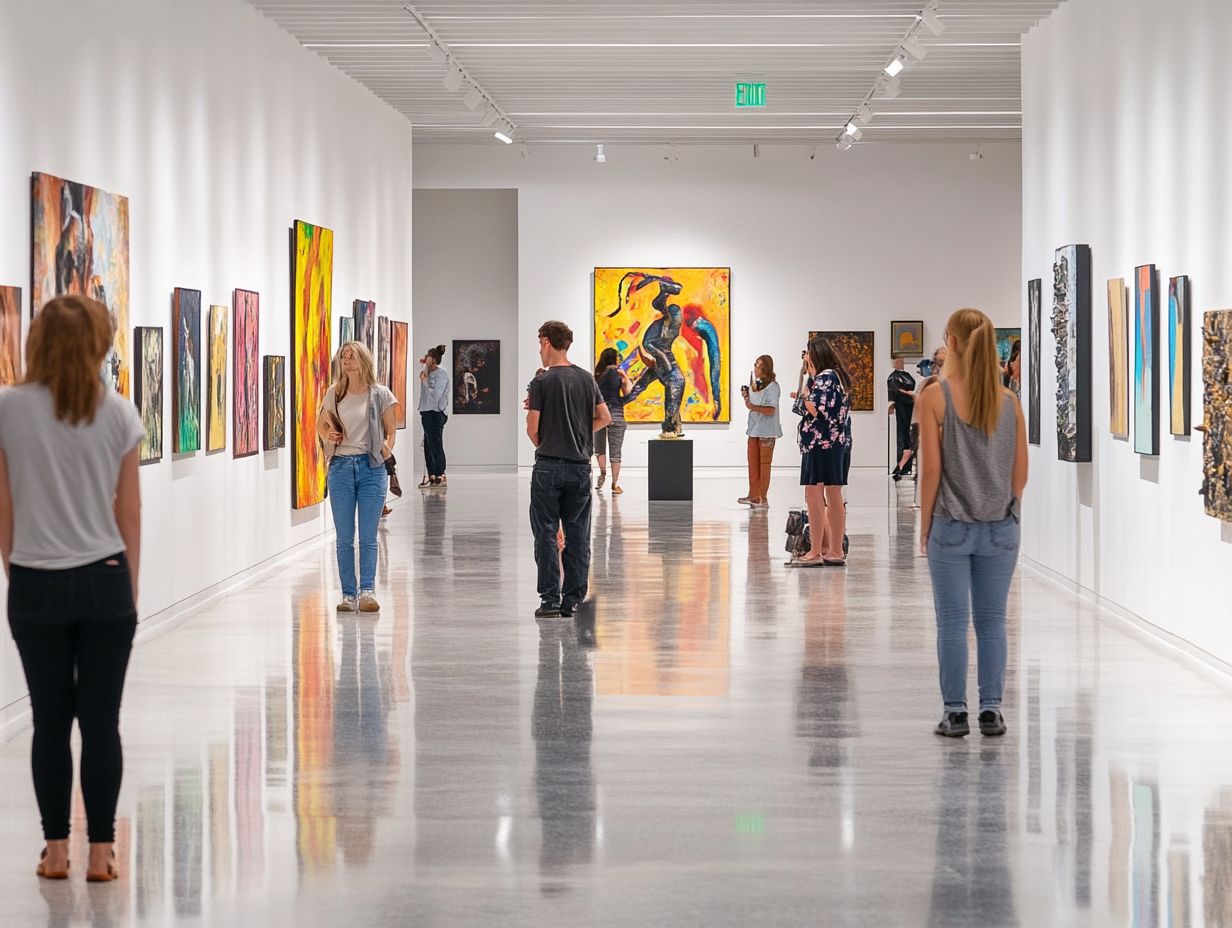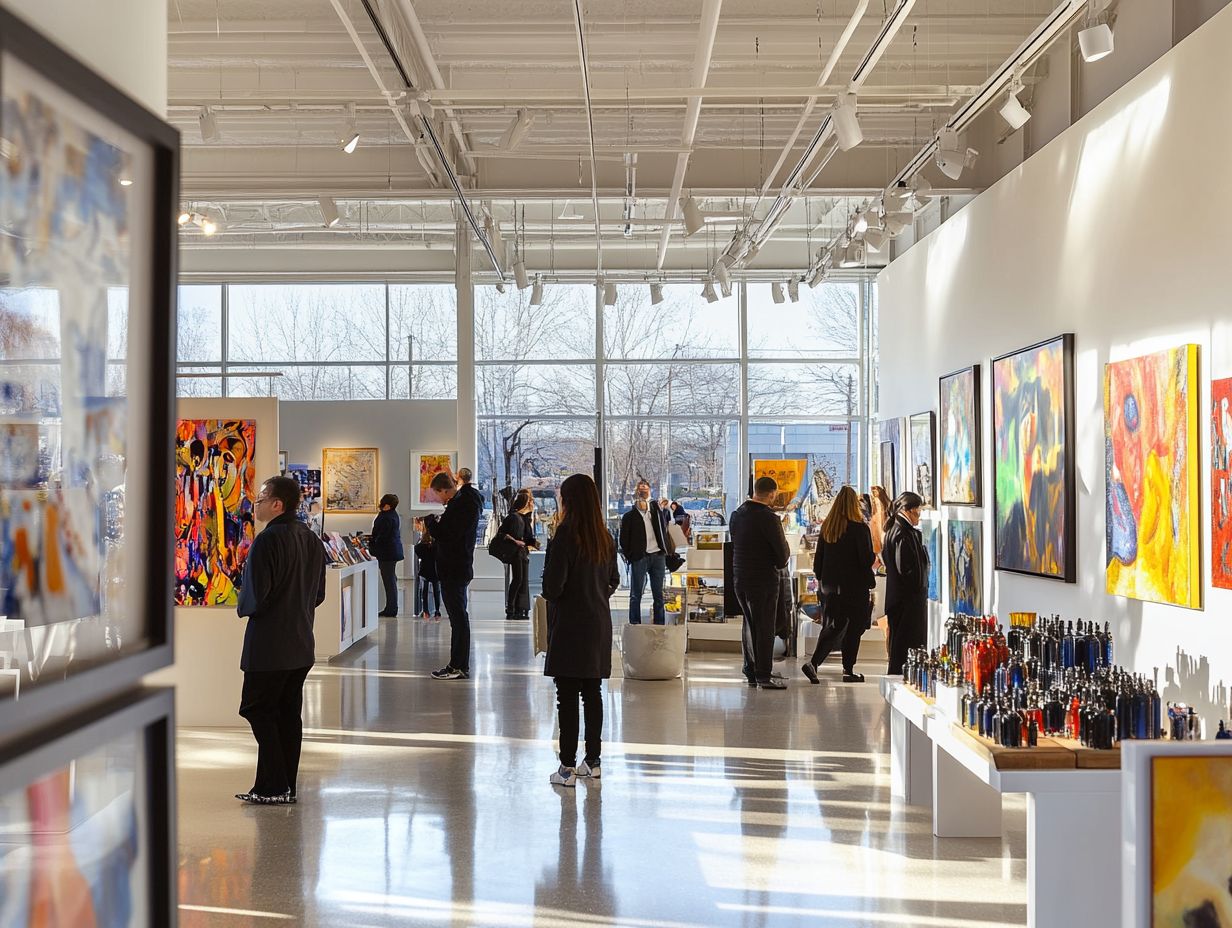The Role of Galleries in Art Collecting
Art galleries hold a crucial place in the cultural landscape. They act as dynamic spaces where creativity flourishes and artistic expression thrives.
Their historical significance and influence on the art market make them important for both artists and collectors. This exploration delves into the various types of galleries, the support they provide to artists, and the unique advantages collectors enjoy by engaging with these institutions.
Whether you consider yourself an avid collector or a casual admirer, grasping the importance of art galleries will deepen your appreciation of the art world.
Contents
- Key Takeaways:
- The Importance of Art Galleries
- Types of Art Galleries
- How Galleries Support Artists
- Benefits of Collecting Art from Galleries
- Frequently Asked Questions
- What is the role of galleries in art collecting?
- How do galleries contribute to the growth of the art market?
- What services do galleries offer to art collectors?
- Can galleries assist in building an art collection?
- Do galleries have a responsibility to educate art collectors?
- What are the benefits of buying art from galleries?
Key Takeaways:
Galleries have significant historical importance in the world of art. They serve as important cultural institutions and shape the art market.
There are two main types of art galleries: commercial galleries, which focus on sales, and non-profit galleries, which prioritize artist support and community engagement.
Galleries play a crucial role in supporting artists by providing exposure, promoting their work, and offering financial support and resources.
The Importance of Art Galleries
Art galleries hold a pivotal position in the contemporary art landscape. They are essential platforms for both emerging and established artists to present their creations.
These spaces do more than host exhibitions they spark conversations about art and enhance the cultural dialogue surrounding artistic expression.
In vibrant cities such as New York and Los Angeles, art galleries function as cultural institutions. They champion art education and foster community engagement.
By providing gallery guides and valuable resources, they invite you to dive deeper into art history and experience its wonders!
Historical Significance of Galleries
The historical significance of art galleries lies in their role as keepers of art history. They showcase works that reflect societal values and artistic trends across the ages.
From their humble beginnings in private collections to the contemporary spaces you encounter today, galleries continually adapt to embrace shifting artistic expressions and cultural dialogues.
Key moments in this evolution include the opening of the Louvre in Paris, which democratized access to art in the late 18th century, and the groundbreaking Armory Show of 1913 in New York, which introduced American audiences to the nuances of European modernism.
Institutions like the Museum of Modern Art have further shaped the market by spotlighting contemporary visionaries. Innovative exhibitions challenge traditional narratives, pushing boundaries and inviting diverse perspectives.
Each development reflects shifts in taste and influences how art is perceived within broader social contexts, making your experience in these spaces all the more enriching.
Role in the Art Market
Art galleries are vital links between artists and collectors. They facilitate sales while influencing the pricing of artworks, particularly through understanding the role of provenance in art collection.
This role becomes even more significant as galleries navigate a landscape filled with ever-changing trends and shifting consumer preferences.
To remain relevant, galleries craft innovative marketing strategies. They showcase their exhibitions and forge strong connections with both seasoned and novice collectors.
By nurturing these relationships, they gain deeper insights into client needs and preferences. This ensures the artwork they present is captivating and valuable.
Managing exhibition proposals is an art form in itself. Galleries assess emerging talents and align their showcases with broader market dynamics.
This strategic approach enhances their visibility and success in promoting new artists, making them essential players in the art world.
Types of Art Galleries
Art galleries fall into two main categories: commercial galleries and non-profit galleries. Each serves a specific purpose and caters to different audiences within the contemporary art ecosystem.
Understanding this distinction enhances your appreciation of the diverse roles these galleries play in the art world.
Visit your local gallery today and discover the magic of art!
Commercial Galleries

Commercial galleries primarily center their efforts on art sales. They showcase emerging artists to entice collectors while expertly navigating the intricate pricing landscape of a competitive market.
By nurturing personal connections with collectors, these galleries foster lasting relationships. These relationships often translate into repeat purchases and valuable referrals.
Employing a range of marketing strategies, such as hosting exclusive events, they elevate the visibility of their featured artists. They also utilize social media to create an inviting atmosphere that encourages engagement and dialogue.
This approach boosts the visibility of artists. It also builds a lively community of art lovers, enriching the overall art-buying experience and establishing the gallery as a vital hub within the local art scene.
Non-Profit Galleries
Non-profit galleries focus on community engagement and celebrate artistic expression. They frequently host exhibitions designed to enhance art education and spark conversations about contemporary issues.
These venues are essential platforms for showcasing local artists. They provide invaluable resources and support through thoughtfully organized workshops. This inspires emerging talents to tap into their creativity.
By organizing events that invite public participation, these galleries strive to break down barriers to art appreciation. They ensure that art is accessible to everyone.
Their mission cultivates spaces where discussions thrive and diverse perspectives are embraced. This ultimately enriches the cultural fabric of the local area.
How Galleries Support Artists
Galleries are your powerful allies on the path to artistic success! They offer essential exposure and promotion critical for cultivating a successful career in the dynamic art market.
Their role in showcasing your work cannot be overstated. They connect you with audiences and collectors, helping to elevate your presence in an ever-evolving landscape.
Exposure and Promotion
Galleries offer invaluable exposure and promotion opportunities through expertly organized exhibitions. These exhibitions connect you with art critics and collectors.
Beyond these exhibitions, galleries employ a variety of effective marketing and promotional strategies. Social media outreach serves as a crucial platform, allowing galleries to engage directly with a wider audience.
They showcase your work through stunning visuals and compelling narratives. Well-crafted press releases capture the attention of journalists and art enthusiasts, drawing attention to your upcoming exhibitions and events.
Participating in art fairs expands the gallery’s reach and creates networking opportunities. This enriches your exposure to potential buyers and collaborators.
Financial Support and Resources
Financial support and access to essential resources from galleries are crucial for advancing your career. This support helps you secure funding for new projects.
These galleries often extend various forms of financial assistance, including grants aimed at fostering creativity. Sponsorship opportunities connect you with brands that share your passion for innovative artistic endeavors.
Beyond funding, galleries frequently offer invaluable connections with art advisors and curators. These connections facilitate introductions that can lead to exhibitions and further opportunities.
Such resources play a pivotal role in creating an environment where you can thrive. They ensure you have the necessary support to navigate the challenges of your artistic practice.
Benefits of Collecting Art from Galleries

Collecting art from galleries offers a wealth of advantages. You gain access to high-quality, authentic artwork that enriches your collection.
This also opens doors to forge meaningful relationships with artists and fellow collectors. Start your art collection today and discover the joy of connecting with incredible artists!
Access to High-Quality and Authentic Artwork
Collecting art from galleries guarantees you ll discover amazing, authentic artworks. Each piece is carefully curated by experienced art professionals.
Galleries play a crucial role in the art market, vetting both artists and their works. You can trust the quality and history of every artwork in your collection, especially with the role of technology in modern art collecting.
When you explore exhibitions of contemporary art, you engage with a narrative reflecting cultural dialogues. This experience deepens your understanding and appreciation of the artist’s intent.
Opportunities for Building Relationships with Artists
Galleries create unique chances to connect with artists, fostering a community that supports their careers. You ll attend events and workshops, enhancing the dialogue between creators and art lovers.
These interactions build trust and create a sense of belonging in the art community. By joining these activities, you ll deepen your appreciation for the art, while artists gain valuable feedback.
These connections shape careers and enrich the art market as a whole.
Frequently Asked Questions
Here are some common questions about galleries and their role in art collecting:
What is the role of galleries in art collecting?
Galleries serve as a platform for artists to showcase their work and connect with potential buyers.
How do galleries contribute to the growth of the art market?

They promote artists, boosting their visibility and creating demand for their work.
What services do galleries offer to art collectors?
Galleries help collectors navigate the art market. They provide expert advice and manage logistics like shipping and installation.
Can galleries assist in building an art collection?
Yes! They introduce collectors to new artists and offer guidance on purchases.
Do galleries have a responsibility to educate art collectors?
Galleries often educate collectors by sharing information about artists and their techniques. This helps collectors make informed decisions.
What are the benefits of buying art from galleries?
Buying from galleries gives you access to a curated selection of high-quality art. You’ll also have the chance to meet and support artists directly, ensuring authenticity.







